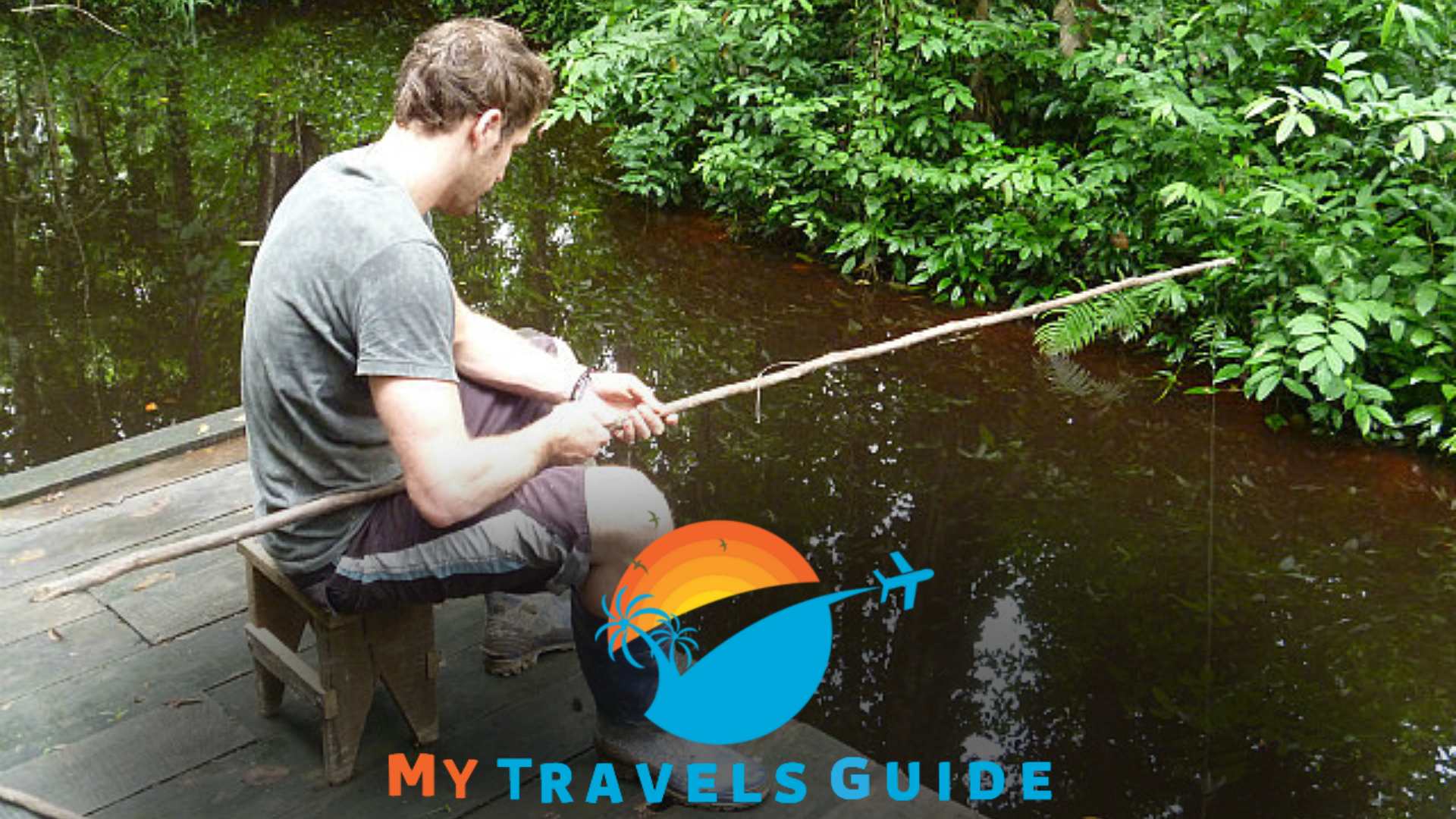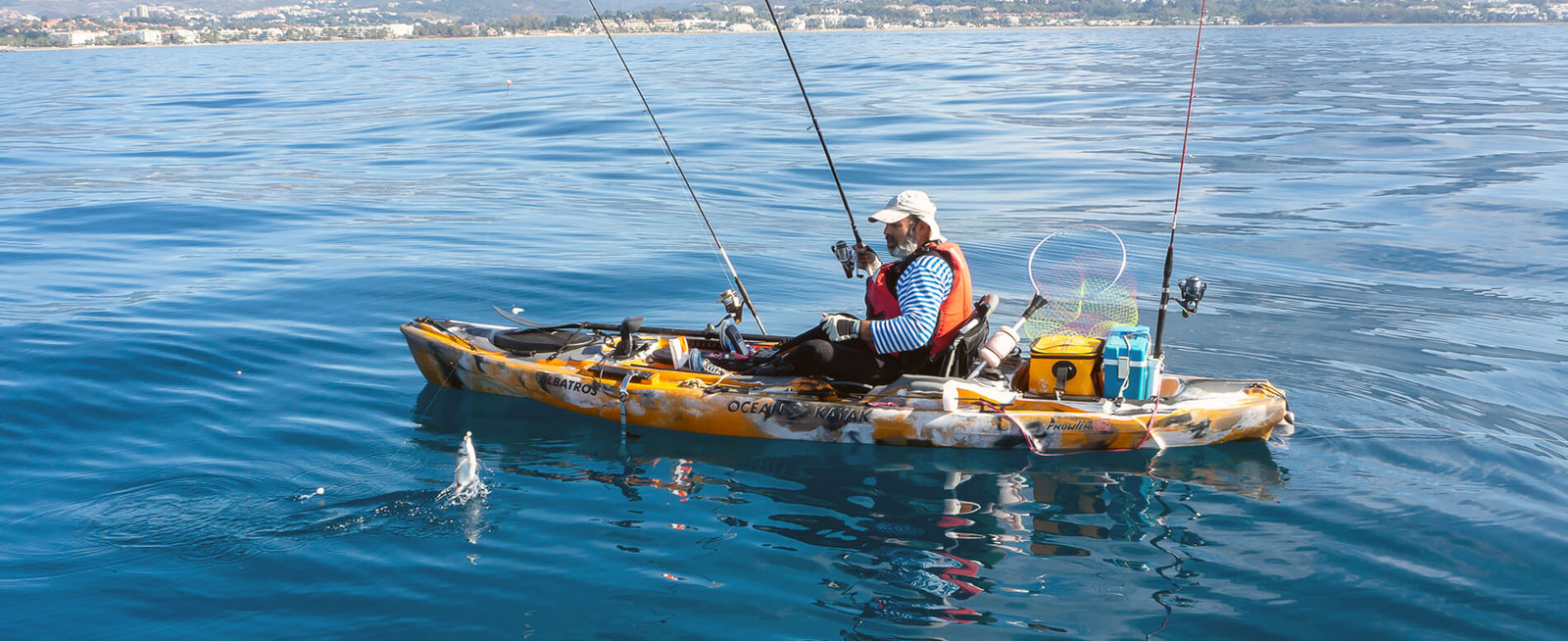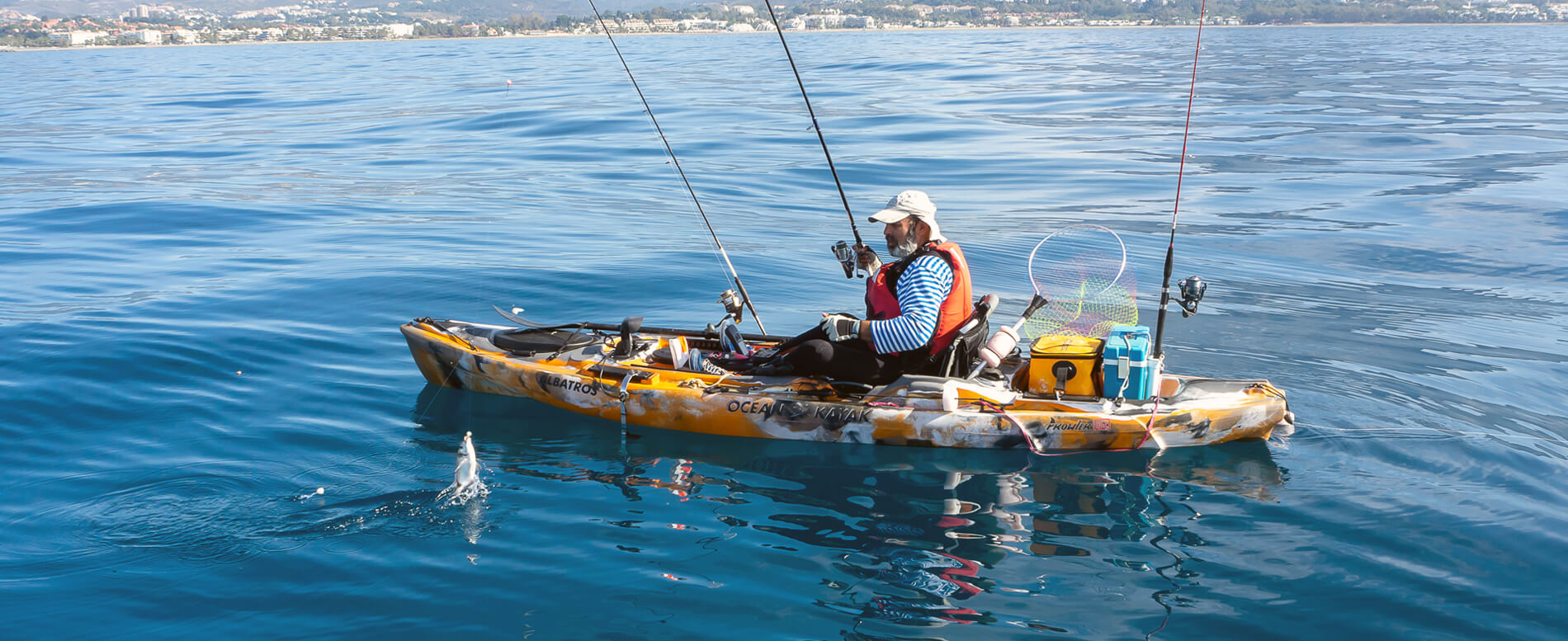Anglers use a rod guide spacing chart or a rod guide spacing tool to ensure an even distribution of perfect fishing rod guides. These tools measure and align guides for optimized rod performance.
Inspect the guides: Check the guides for any burrs or irregularities that might damage the rod blank. Use a file to smooth out any rough spots.
Mark the Guide Spacing: Use a china marker to mark where the guides will go on your rod blank. The spacing is usually measured from the tip down to the butt end. The marks should represent where the ring of the guide will line up, not the guide’s foot.
Secure the guides: Use rod-building masking tape to secure the guides to the blank. Align the ring with the mark you measured out earlier.
Spacing Chart: Refer to a guide spacing chart specific to your rod length and type. Many rod component suppliers provide these charts, which are essential for precise guide placement.
Static Load Test: After taping the guides, perform a static load test by running the line through the guides and placing a slight bend in the rod to ensure the line does not touch the blank.
Remember, the exact spacing can vary depending on the length and action of your rod, as well as the size of the guides. For detailed instructions and spacing charts, you can refer to resources like Mud Hole Custom Tackle² or watch instructional videos such as “How-To Prep & Space Out Your Guides | Rod Building 101” on YouTube¹. These resources will provide you with the specific measurements and techniques to achieve perfect guide spacing on your fishing rod. 🎣🛠️

Introduction To Rod Building
Introduction to Rod Building unlocks a world of customization for avid anglers. This process transforms the fishing rod into a personalized tool. It reflects individual styles and fishing needs. Crafting your rod allows for precision and innovation. Mastery of your fishing experience begins here. Let’s dive into the art of rod building.
The Art Of Customizing Your Fishing Experience
Creating a bespoke fishing rod sets you apart from the crowd. Each choice in the rod-building process is a step towards tailor-made performance. Adjustments to length, grip, action, and guide placement create a unique rod. This rod feels like an extension of the fisherman’s intent. This art balances aesthetics with functionality for an unmatched fishing journey.
Components Of A Fishing Rod
A fishing rod comprises several key parts:
- Blank: the core of the rod, providing structure and action.
- Guides: rings that direct the fishing line along the rod.
- Handle: The section where the angler grips the rod.
- Reel Seat: Where the reel attaches to the rod.
- Tips: The end piece that fine-tunes sensitivity and action.
- Wraps: thread wraps that secure guides and add a personal touch.
Spacing rod guides evenly is crucial for performance. It ensures balance and a smooth line flow. This task, often daunting for newcomers, is simplified with the right tools and techniques.
Credit: mytravelsgyde.com
Significance Of Guide Placement
The significance of guide placement on a fishing rod cannot be overstated. Ensuring guides are evenly spaced along the rod helps in multiple ways. Right placement affects casting efficiency, the rod’s balance, and how stress distributes while reeling in a catch. Using the correct tool for this job guarantees precision and enhances the overall fishing experience.
Efficiency And Accuracy In Casting
When guides align evenly, casting becomes a breeze. Control improves, and anglers experience less friction during the cast. This can mean longer and more accurate casts. A common tool used for this is a rod guide spacing chart. This chart helps in marking precise guide positions before installation.
- Easier line flow
- Longer casts
- Less tangles and wind knots
Balance And Stress Distribution
Proper guide placement also plays a crucial role in how a rod feels and operates under stress. It affects balance and the way force distributes when fighting a fish. Tools such as guide spacing rulers and tape measures are essential in maintaining equal distances between guides, leading to a well-balanced rod.
| Guide Position | Effect on Rod |
|---|---|
| Evenly Spaced | Better Balance |
| Correctly Aligned | Optimal Stress Distribution |
Tools For Spacing Rod Guides
Creating the perfect fishing rod requires precision, especially when spacing the guides. Tools and techniques vary widely, but some stand out for their effectiveness. Below, explore the tools that can help achieve uniform guide distribution for an optimal rod assembly.
Guide Spacing Charts
Essential for every rod builder is a guide spacing chart. Charts provide a starting point for guide placement, tailored to the rod’s length and type. The information is usually presented in an easy-to-follow format. Here’s an example:
| Rod Length | Guide Number | Distance from Tip (inches) |
|---|---|---|
| 7 ft | 1 | 5 |
| 7 ft | 2 | 11 |
Use a chart as a guide to mark each location on your rod blank.
Rod Building Jigs And Stands
For hands-on precision, rod builders often turn to jigs and stands. These tools stabilize your rod, allowing for accurate measurements and guide placement. A list of some common tools includes:
- Guide wrapping jigs: to keep guides in place while wrapping
- Magnetic spacing tools: for consistent guide intervals
- Measuring lasers: for precise distance calculations
With a solid jig or stand, expect a smoother building process with evenly spaced guides. This leads to better rod performance and more enjoyable fishing.
Guide Spacing Rule
Ever wonder how to get perfect spacing for your fishing rod guides? The Guide Spacing Rule is your answer. It ensures your fishing rod bends evenly with no weak spots. Perfectly spaced guides mean better performance and a tougher rod. This rule is the secret to an evenly responsive rod from grip to tip.
The Static Load Method
The static load method helps you see where guides should sit. Begin by threading the rod and bending it. Watch where the rod curves most. Place your guides to support these bends. This method ensures each guide carries its share of the load. This results in a stronger, more balanced rod. Your rod stays tough even when that big catch is bending it.
Step-by-step Guide Spacing Calculation
- Measure Your Rod: Start with the full length of your rod. You need this to calculate guide spacing.
- Count Your Guides: Know the total number of guides you will use. More guides equal better weight distribution.
- First and Last Guide Positions: Generally, place the first guide close to the reel. The last one goes near the rod tip.
- Spacing Formula: Use a guide spacing chart or formula suited for your rod length and number of guides.
- Mark your spots: Use a marker or a piece of tape to note where each guide will go on the rod. Check twice to be sure!
- Test the spacing: Set the guides on the marks. Thread the line through and bend the rod. Adjust as needed for even bends.
This calculation helps you space out the guides evenly. Your goal is a balanced rod with a smooth curve under pressure. It will cast further and fight fish better.
Using The Tape Measure Technique
The Tape Measure Technique: When assembling a fishing rod, spacing the guides evenly is crucial for the rod’s balance and performance. One method that stands out for its simplicity and reliability is using a tape measure. This technique involves careful manual measurements, ensuring your rod guides are spaced precisely along the blank. Let’s delve into how to accomplish this with a tape measure.
Pros And Cons Of Manual Measurements
Pros:
- Easy to use and widely available.
- Cost-effective, requiring no special equipment.
- Offers a hands-on approach to customization.
Cons:
- Can be time-consuming.
- Possibility of human error if not careful.
- May require recalibration for each rod build.
Tips For Improved Precision
- Ensure your tape measure is accurate and in good condition.
- Use a fine-point marker for clear guide placement marks.
- Double-check measurements before finalizing positions.
- Use a rod-building jig or some reference points to maintain alignment.
Computer Software For Guide Placement
Mastering the art of fishing rod customization just got easier with computer software for guide placement. Picture-perfect spacing of fishing rod guides is no longer left to traditional trial-and-error methods. This digital leap ensures the utmost accuracy and performance for anglers of all levels.
Advancements In Rod Design Software
Software solutions now offer precise calculations and visualizations for guide placement. This technology accounts for complex variables. These include rod curves, flexibility, and the angler’s specific style. These calculations were once done manually, often leading to inconsistent results. Now, precision is just a few clicks away.
Features of this advanced software may include:
- Custom guide spacing algorithms
- 3D rod modeling
- Real-time stress distribution analysis
Integrating Technology With Tradition
Fishing remains an age-old tradition. Yet, the integration of modern technology enhances this timeless pursuit.
The synergy between traditional rod crafting and cutting-edge software is evident. Rod builders embrace technology while keeping true to their craft. The respect for the old ways amplifies through the precision of the new.
The advancements assure a balanced, efficient, and effective fishing experience. Craftsmen and anglers can witness:
| Traditional Technique | Technological Improvement |
|---|---|
| Manual Guide Placement | Digital Precision |
| Estimation of Flex Points | Exact Stress Analysis |
Expert Tips For Perfect Guide Placement
Positioning fishing rod guides with precision is essential for a balanced, efficient rod. A well-spaced set of guides ensures smooth line movement and better control during a catch. Professional rod builders often use specific tools and techniques to achieve this level of perfection.
Learning From Seasoned Rod Builders
Experience counts when placing guides on a fishing rod. Seek wisdom from experts who have refined their methods through trial and error. They often use special spacing charts and the static load test to determine the optimal positions.
- Measure the rod length appropriately.
- Use a spacing chart as a starting point.
- Adjust based on rod action and strength.
- Perform a static load test to fine-tune placement.
Common Pitfalls To Avoid
Amateur rod builders might make mistakes without proper guidance. Common spacing errors can affect performance and durability.
| Pitfall | Effect |
|---|---|
| Overcrowding guides | Increases weight and reduces flexibility. |
| Staggered spacing | Causes uneven stress and potential breakage. |
| Ignoring guide size | Impedes line flow and casting distance. |
To prevent these issues, follow established spacing guidelines. Use precise measuring tools and double-check all placements.
- Ensure even guide distribution along the rod.
- Match guide sizes for optimal performance.
- Recheck positions before final installation.

Credit: www.gilisports.com
The Final Step: Wrapping And Aligning
Spacing fishing rod guides is like threading a needle in a craftsman’s world. Wrapping and aligning rod guides is a critical step. It ensures your fishing line glides smoothly. The art is all about precision and patience. Let’s dive into the technique of securing each guide with finesse and aligning them to perfection.
Securing Guides With Thread Wraps
Once you have spaced your guides evenly, it’s time to secure them. You’ll use a strong thread for this. Here’s how to make sure your guides stay put:
- Choose the right thread: A nylon or silk thread is perfect. Make sure it is thin but strong.
- Start the wrap: Anchor the guide with a few tight turns of thread.
- Keep tension: Maintain a firm tension to prevent any slips or gaps.
- Finish with a knot: Use a special rod wrapping knot to finish the wrap.
Ensuring Perfect Guide Alignment
The guides must form a straight line along the length of the rod. This line is your path to a perfect cast. Follow these simple steps to ensure your guides are aligned:
- Eye it up: Look down the rod from above to check alignment.
- Use a straight edge: Lay a ruler or a specially designed tool along the rod.
- Adjust as necessary: If a guide is out of line, gently tweak it until it’s perfect.
| Step | Tip |
|---|---|
| Visual Check | Look down the rod’s length for a bird’s eye view. |
| Straight Edge Use | A ruler or alignment tool simplifies the process. |
| Final Adjustments | Correct any misaligned guides with careful precision. |
Maintenance And Adjustments
Keeping your fishing rod in top shape includes regular guide maintenance. Properly spaced guides ensure smooth casting and reeling. Over time, they require adjustments due to normal wear and tear. Learn how to maintain and adjust them for the best fishing experience.
Regular Check-ups And Cleaning
Maintaining the optimal performance of your fishing rod involves periodic inspections and cleanliness. Dirt and salt can build up, causing damage over time. Follow these steps for regular check-ups:
- Inspect guides for alignment.
- Check for signs of corrosion or damage.
- Use a soft cloth and a mild soap solution to clean each guide.
- Dry thoroughly to prevent rust.
How To Adjust Guides After Wear And Tear
Guides can shift or become uneven. To adjust them, follow these steps:
- Loosen the guide bindings gently.
- Reposition the guide to the correct spacing.
- Tighten the bindings without overtightening.
- Test the rod’s action to ensure smoothness.
Tools like the rod wrapping jig simplify this process. They hold the rod and guides in place while you work. Consistent spacing is the key to peak rod performance.

Credit: www.gilisports.com
Frequently Asked Questions On What Tool Do You Use To Space Fishing Rod Guides Evenly Along The Rod?
What Is A Fishing Rod Guide Spacing Chart?
A fishing rod guide spacing chart is a reference tool that provides detailed measurements for positioning rod guides. It ensures guides are evenly spaced along the rod to optimize performance.
How Does Guide Spacing Affect Rod Performance?
Proper guide spacing ensures efficient load distribution when casting and retrieving. It reduces line friction, improves accuracy, and enhances the overall fishing experience.
Can I Space Rod Guides Without a Tool?
Spacing rod guides without a tool is possible, but challenging. Using a tool or chart helps achieve precise, even spacing for optimal rod performance and is highly recommended.
Are There Diy Methods For Spacing Fishing Rod Guides?
Yes, there are DIY methods using measuring tape and simple calculations. However, for best results, a spacing chart or specialized spacing tool is preferred.
Conclusion
Selecting the right tool for spacing your fishing rod guides is crucial for optimal rod performance. The Rod Guide Spacing Chart stands out as the go-to resource. It offers precision, ensuring evenly spaced guides and a balanced rod. For avid anglers and rod builders alike, this chart is an indispensable ally in your fishing adventures.
Embrace it for your next project, and witness the difference in your rod’s action and sensitivity.

